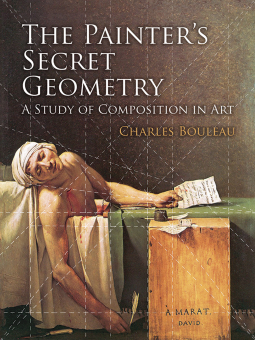
The Painter's Secret Geometry
A Study of Composition in Art
by Charles Bouleau
This title was previously available on NetGalley and is now archived.
Send NetGalley books directly to your Kindle or Kindle app
1
To read on a Kindle or Kindle app, please add kindle@netgalley.com as an approved email address to receive files in your Amazon account. Click here for step-by-step instructions.
2
Also find your Kindle email address within your Amazon account, and enter it here.
Pub Date Aug 20 2014 | Archive Date Feb 12 2015
Description
Advancing step by step through each painter's vast body of work, the survey highlights new contributions from each period and artist. Every analysis is conducted according to strict methods, placing the work within the intellectual atmosphere of its time. Original, informative, and stimulating, The Painter's Secret Geometry reveals the framework of art as well as its most profound and secret poetry. This new edition of the cult classic is a vade mecum for any student of art history or artistic composition.
Available Editions
| EDITION | Paperback |
| ISBN | 9780486780405 |
| PRICE | $21.95 (USD) |
Average rating from 16 members
Featured Reviews
 Karen R, Reviewer
Karen R, Reviewer
A real handy book for scholars and artists. I truly enjoy the supernatural and natural aspects of our gifts and talents. I have a friend who is a teacher of math and loves art. It's her brain that appreciates the science and math of creative artistic expression.
 Joseph S, Reviewer
Joseph S, Reviewer
The Painter’s Secret Geometry: A Study of Composition in Art by Charles Bouleau is a reprint of the 1963 edition of the book. The author makes it clear that this is not an art history book or comprehensive study of art, but a narrowly themed book on how geometry played a role in earlier works of art.
To start with I do know a little about art, but nowhere enough to be considered an expert or scholar on the subject. I have a masters degree in liberal arts and was lucky enough to visit plenty of museums while stationed in Europe. I know a Monet from a Picasso and a Dali from a Rembrandt. I have an appreciation for art and for mathematics too. I am one of those people who think mathematics is the key to understanding the world around us. There is symmetry in nature. Leaves, shells, pollen, crystals, rivers can be shown mathematically through fractals. Might there be something that makes some art more pleasing to the eyes than others? Might that be based on geometry?
Bouleau starts with an easy enough topic of scale. In very early works of art scale was used to express importance. The pharaoh dwarfed his subjects in size in Egyptian art. Gods likewise, when in human form, were drawn well taller than the people they addressed. It wasn’t until the Greeks that gods were scaled down to man size. Other early works show the subject bent or with a curved back symbolizing the frame of the picture was too small to contain the subject. In Bronzino’s Allegory of Love, the subjects bend and allow their bodies to conform to the frame. They form almost a perfect rectangle against the borders of the canvas. Heads were drawn proportionally smaller on show a subject of greater size. The explanations in these early works were interesting. The real focus of the book came with medieval and later painters.
I always found Medieval art interesting for a number of reasons. One reason is that the complete painting looks pleasing to the eye, but on closer examination individual objects or people in the painting seem off. There is a tree that looks like an asparagus stem or a child that seems disproportionate in size when singled out in the painting. One wonders why these oddly shaped objects do not attract attention when viewed in the entire painting. The answer seems to be it is because they are oddly shaped or placed that they work in the painting. The human mind looks for patterns. Optical illusions delight us. We enjoy music with rhythm and a beat. We can tell when something is out of place or out of sequence. We may not know what is out of place, but something is just not quite right. The same works with art.
There is a geometry in art. In some works, it is Euclidian geometry. In others, addition of musical tones is added the geometry. Botticelli’s Primavera is used as one example. Bouleau superimposes the geometric lines and patterns over the works of art. In many of the cases, the results are stunning. There is more than a causal relationship between positioning and the subjects to the geometry of the canvas. Piero della Francesca’s The Virgin and Child with Saints is mind blowing, the subjects and the background fit perfectly. It seems that Francesca drew his subjects over a visually pleasing geometric pattern right down to the angle that the child lies across the Virgin. Perhaps my favorite painting, School of Athens by Raphael, in the foreground Pythagoras is explaining the musical consonances where the ratio of 4/6/9 is derived from. This ratio became known as the golden ratio and is used in much of the painting of the time.
Poussin’s Rape of Sabines is used as another example of ratios The painting is overlayed with lines in a ratio of 9/16. This moves the vanishing point to the left of center and the horizon above the center of the canvas, but visually it appears in the center of the painting. The people on the right are larger and the buildings on the right seem to move out to the viewer. The viewer placed in the lower right of the painting viewing as a member of the crowd in a seemingly three dimensional experience.
Many paintings are covered and some modern work is also shown. Works where the geometry plays an important role as in modern art where there may not be a subject or a traditional subject. When we look at anything there are two things we see what is on the surface and the mind sees something more. Much like the ideal of a subliminal message, the conscious sees one thing and the mind sees another. The overlays over the paintings used by Bouleau show us what our minds see when looking at art -- pattern, symmetry, ratios, vanishing points. The use of modern art near the end of the book may go on to support the idea that we are attracted to the patterns and symmetry much more than we may be attracted to the subject of the painting. What makes the art great may boil down to not what we see, but what our mind sees.
Also post on Goodreads https://www.goodreads.com/review/show/1100904005
 janet k, Librarian
janet k, Librarian
I found the material presented in this book to be fascinating. Though originally published in the 1960's it's tenets hold up well. I read it slowly, and found myself flipping back and forth between examples in order to best understand the concepts. It would lend itself well to an art history course or to anyone interested in the concepts outlines. A strong contender for book discussion groups.
*I received my copy from NetGalley,com in exchange for an honest review.
Readers who liked this book also liked:
L.M. Montgomery, Crystal S. Chan, Kuma Chan
Children's Fiction, Comics, Graphic Novels, Manga, Teens & YA


















